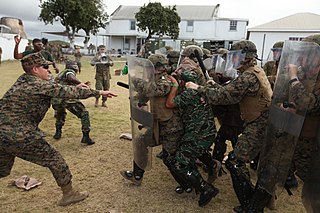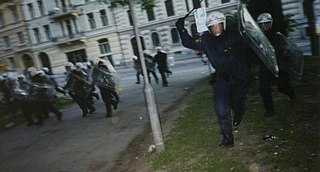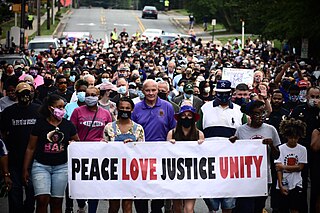Related Research Articles

A riot or mob violence is a form of civil disorder commonly characterized by a group lashing out in a violent public disturbance against authority, property, or people.
Civil disorder, also known as civil disturbance, civil unrest, or turmoil, are situations when law enforcement struggle to maintain public order or tranquility.

Riot control measures are used by law enforcement, military, paramilitary or security forces to control, disperse, and arrest people who are involved in a riot, unlawful demonstration or unlawful protest.

The 1981 Brixton riot, or Brixton uprising, was a series of clashes between mainly black youths and the Metropolitan Police in Brixton, London, between 10 and 12 April 1981. It resulted from racist discrimination against the black community by the mainly white police, especially the police's increased use of stop-and-search in the area, and ongoing tensions resulting from the deaths of 13 black teenagers and young adults in the suspicious New Cross house fire that January. The main riot on 11 April, dubbed "Bloody Saturday" by Time magazine, resulted in 279 injuries to police and 45 injuries to members of the public; over a hundred vehicles were burned, including 56 police vehicles; almost 150 buildings were damaged, thirty of which were burnt out, and many shops were looted. There were 82 arrests. Reports suggested that up to 5,000 people were involved. The Brixton riot was followed by similar riots in July in many other English cities and towns. The Thatcher government commissioned an inquiry, which resulted in the Scarman Report.

The 1992 Los Angeles riots were a series of riots and civil disturbances that occurred in Los Angeles County, California, United States, during April and May 1992. Unrest began in South Central Los Angeles on April 29, after a jury acquitted four officers of the Los Angeles Police Department (LAPD) charged with using excessive force in the arrest and beating of Rodney King. The incident had been videotaped by George Holliday, who was a bystander to the incident, and was heavily broadcast in various news and media outlets.
The 1967 Newark riots were an episode of violent, armed conflict in the streets of Newark, New Jersey. Taking place over a four-day period, the Newark riots resulted in at least 26 deaths and hundreds more serious injuries. Serious property damage, including shattered storefronts and fires caused by arson, left much of the city's buildings damaged or destroyed. At the height of the conflict, the National Guard was called upon to occupy the city with tanks and other military equipment, leading to iconic media depictions that were considered particularly shocking when shared in the national press. In the aftermath of the riots, Newark was quite rapidly abandoned by many of its remaining middle-class and affluent residents, as well as much of its white working-class population. This accelerated flight led to a decades-long period of disinvestment and urban blight, including soaring crime rates and gang activity.
The 1991 Washington, D.C., riot, sometimes referred to as the Mount Pleasant riot or Mount Pleasant Disturbance, occurred in May 1991, when rioting broke out in the Mount Pleasant neighborhood of Washington, D.C., in response to an African-American female police officer having shot a Salvadoran man in the chest following a Cinco de Mayo celebration.
The Territorial Support Group (TSG) is a Met Operations unit of London's Metropolitan Police Service (MPS) which specialises in public order policing, amongst other specialist areas. In 2012 it consisted of 793 officers and 29 support staff. The TSG is a uniformed unit of the MPS that replaced the similarly constituted Special Patrol Group in 1987. TSG units patrol the streets of London in marked police vans or "carriers"; using the call sign prefix "Uniform". Generally each carrier has an advanced (police) driver, seven constables and a sergeant. Territorial Support Groups often comprise three carriers, twenty one constables, and three sergeants reporting to an Inspector. They separately patrol designated areas experiencing serious levels of gang violence or disorder. When deployed, it is by the MPS Information Room. Due to the public order nature of their role often numerous carriers will be assigned. TSG officers can be identified as TSG from the distinctive "U" in their shoulder numbers. Some TSG officers are also plainclothes officers, carrying a taser and handcuffs.

A baton charge is a coordinated tactic for dispersing crowds of people, usually used by police, paramilitary or military in response to public disorder. In the Indian subcontinent, a long bamboo stick, called lathi in Hindi and Urdu, is used for crowd control, and the expression lathi charge commonly employed to describe the action.
In July 1981, the inner-city district of Moss Side in Manchester, England, was the scene of mass protesting. The protests at Moss Side started at the local police station and later moved into the surrounding streets over two days. Key factors seen as fuel for this protest were racial tension, due to frequent allegations of police officers racially abusing and using excessive force against black youths in the area, and mass unemployment brought on by the early 1980s recession. Unemployment was at a post-war high across the nation during 1981, but was much higher than the national average in Moss Side.

In early August 2011, England was struck by riots, the worst in the country in decades. The timeline of the events of the riots spanned from 6–10 August.

Operations Support Group (OSG) police are specialist police within the New South Wales Police Force. They are trained in public order (riot) response; weaponless control ; violent prisoner cell extractions; high-value asset protection; navigation and terrain search; bomb searching; and chemical, biological, radiological and nuclear (CBRN) response.

On 15 September 2012, a protest against the anti-Islamic film Innocence of Muslims was held in Sydney, New South Wales. While the protest started peacefully, violent confrontations between police and protesters began when protesters reached the United States Consulate General. In resulting clashes, six police officers and 19 protesters were injured. The violence was condemned by Australian political leaders, including Prime Minister Julia Gillard. Police arrested nine protesters in connection with the violence.

On April 12, 2015, Baltimore Police Department officers arrested Freddie Gray, a 25-year-old African American resident of Baltimore, Maryland. Gray's neck and spine were injured while he was in a police vehicle and he went into a coma. On April 18, there were protests in front of the Western district police station. Gray died on April 19.
The 2014 Oakland riots were a series of riots and civil disturbances that took place in Oakland, California and surrounding areas in November and December 2014. On November 24, 2014, following the decision of a Grand Jury in St. Louis to not charge Darren Wilson in the shooting death of black teenager Michael Brown, protests and rioting broke out in Oakland and later spread to other Bay Area cities. For more than two weeks, the Bay Area was the site of civil unrest as protesters clashed with police and damaged public and private property.
The George Floyd protests in Chicago were a series of civil disturbances in 2020 in the city of Chicago, Illinois. Unrest in the city began as a response to the murder of George Floyd in police custody in Minneapolis on May 25, 2020. The demonstrations and riots, supporting justice for Floyd and protesting police brutality, occurred simultaneously with those of over 100 other cities in the United States. Chicago is among 12 major cities that declared curfews in order to prevent looting and vandalism. On May 31, Mayor Lori Lightfoot asked Illinois Governor J.B. Pritzker to send the Illinois National Guard to Chicago for the first time in the 52 years since the 1968 riots in Chicago. The economic damage caused by the disturbances exceeded $66 million.
There were a series of George Floyd protests in Illinois. Demonstrations and protests were held in at least 30 communities around the state, with major demonstrations happening in Chicago.

This is a list of George Floyd protests in North Carolina, United States.
Local protests in the Minneapolis–Saint Paul metropolitan area quickly spread nationwide in more than 2,000 cities and towns, as well as over 60 countries internationally in support of the Black Lives Matter movement. In Minneapolis, destruction of property began on May 26, 2020, with the protests involving vandalism and arson. Demonstrations in many other cities also descended into riots and widespread looting. There was police brutality against protesters and journalists. Property damage estimates resulting from arson, vandalism and looting ranged from $1 to $2 billion, eclipsing the highest inflation adjusted totals for the 1992 Los Angeles riots.
The 1967 New York City riot was one of many riots that occurred during the long, hot summer of 1967. The riot began after an off-duty police officer, Patrolman Anthony Cinquemani, while trying to break up a fight, shot and killed a Puerto Rican man named Renaldo Rodriquez who had a knife and lunged toward him.